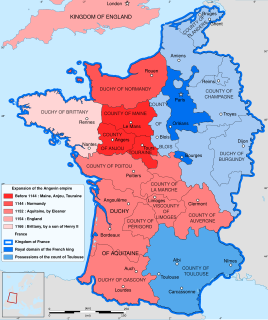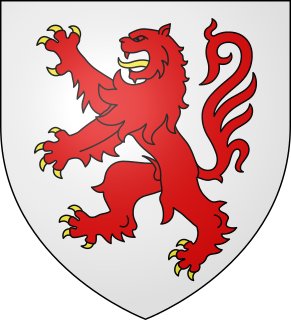This article needs additional citations for verification .(December 2009) (Learn how and when to remove this template message) |
Among the people who have borne the title of Count of Poitiers (or Poitou , in what is now France but in the Middle Ages became part of Aquitaine) are:
Count (Male), or Countess (Female), is a historical title of nobility in certain European countries, varying in relative status, generally of middling rank in the hierarchy of nobility. The etymologically related English term, "county" denoted the land owned by a count. Equivalents of the rank of count exist or have existed in the nobility structures of some non-European countries, such as hakushaku during the Japanese Imperial era.

Poitiers is a city on the Clain river in west-central France. It is a commune and the capital of the Vienne department and also of the Poitou. Poitiers is a major university centre. The centre of town is picturesque and its streets include predominantly historical architecture, especially religious architecture and especially from the Romanesque period. Two major battles took place near the city: in 732, the Battle of Poitiers, in which the Franks commanded by Charles Martel halted the expansion of the Umayyad Caliphate, and in 1356, the Battle of Poitiers, a key victory for the English forces during the Hundred Years' War. This battle's consequences partly provoked the Jacquerie.

Poitou was a province of west-central France whose capital city was Poitiers.
Warinus of Poitiers was the Franco-Burgundian Count of Poitiers and Count of Paris and later Saint Warinus, Martyr of the Franks. He was the son of Saint Sigrada of Sainte-Marie de Soissons and the brother of Saint Leodegarius. He was the father of Saint Leudwinus.
Carolingian Counts
- Bernard I (814-828)
- Renaud (795–843)
- Bernard II (840 - 844)
- Emenon or Emeno (828 – 839), brother of Bernard II
- Ranulph I (839–866)
- Ranulph II (866–890), [1] son of Ranulph I
- Gauzbert (857–892)
- Robert I (866–923)
- Ebalus (or Ebles Manzer) (890–892) (illegitimate son of Ranulph II)(first reign– 890–893)(second reign– 902–935) [1]
- Aymar (892–902) (son of Emenon)
- Ebalus (or Ebles Manzer) (restored) (902–935) [1]
- William I (935–963) (son of Ebalus) [1]
- William II (963–995) (son of William I) [1]
- William III (969–1030) (son of William II) [1]
- William IV (1030–1038) (1st son of William III) [1]
- Odo (Eudes) (1038–1039) (2nd son of William III) [1]
- William V (1039–1058) (3rd son of William III) [1]
- William VI (1058–1086) (4th son of William III) [1]
- William VII (1071–1126) (son of William VI) [1]
- William VIII (1099–1137) (son of William VII) [1]
- Eleanor, Duchess of Aquitaine [1]
- Louis VII of France (1137–1152) obtained title through marriage to Eleanor [1]
- Henry II of England (1152, 1156–1189) obtained title through marriage to Eleanor [1]

Louis VII, called the Younger or the Young, was King of the Franks from 1137 to 1180. He was the son and successor of King Louis VI, hence his nickname, and married Duchess Eleanor of Aquitaine, one of the wealthiest and most powerful women in western Europe. The marriage temporarily extended the Capetian lands to the Pyrenees, but was annulled in 1152 after no male heir was produced.

Henry II, also known as Henry Curtmantle, Henry FitzEmpress or Henry Plantagenet, ruled as King of England, Duke of Normandy and Aquitaine, Count of Anjou, Maine, and Nantes; at various times, he also partially controlled Scotland, Wales and the Duchy of Brittany. Before he was 40 he controlled England, large parts of Wales, the eastern half of Ireland and the western half of France—an area that would later come to be called the Angevin Empire.
- William IX (1153–1156) son of Eleanor and Henry II of England
- Richard I (1169–1196) son of Eleanor and Henry II of England [1]
- Otto (1196–1198)
- Richard I again (1198–1199) [1]
- Richard II (1224) younger brother of Henry III of England
- Alphonse I (1220–1271) son of Louis VIII of France
- Philip I (1293–1322)
- John I (1319–1364)
- John II (1340–1416) son of John I
- John III (1398–1417) son of Charles VI of France
- Charles (1403–1461)
- Francis (r. 1695–1715)
Bernard II was the count of Poitou from 840 until his death. His ancestry is uncertain. He was most likely the son of Bernard I, on the basis of onomastics. He was probably a member of the Guilhemid family. His brothers were Turpio and Emenon, counts of Angoulême and Périgord, respectively.
Emenon was the Count of Poitou (828–839), Périgord (863–866), and Angoulême (863–866). He was most likely the son of Bernard I, Count of Poitiers, on the basis of onomastics.

Robert I of France was the elected King of West Francia from 922 to 923. Before his election to the throne he was Count of Poitiers, Count of Paris and Marquis of Neustria and Orléans. He succeeded the overthrown Carolingian king Charles the Simple, who in 898 had succeeded Robert's brother, king Odo.

